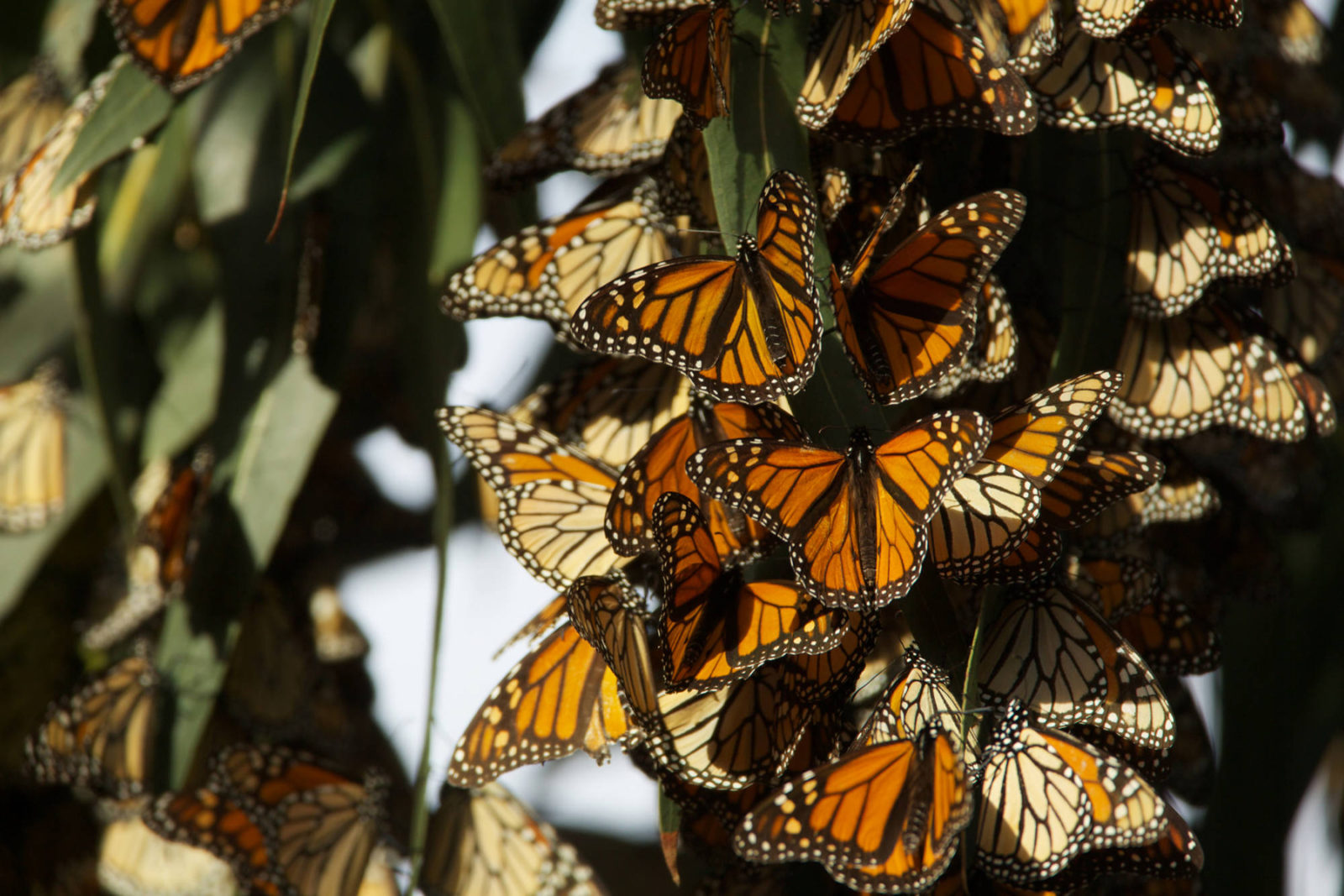So far, 2021 has been a great butterfly year for me. In April I waded through throngs of variable checkerspots on San Bruno Mountain. In June I marveled as dozens of California sisters came zinging across my path on Mount Tam. Likewise, the Portola redwoods were dancing with sisters in early July. Just a few weeks ago I marched around Serene Lake near Donner Pass, gob-smacked at the abundance and variety of fritillaries – Western Meadow fritillaries, Zerene fritillaries, Mormon fritillaries! Every sighting has filled me with joy. Butterfly (and all insect) numbers have been vastly reduced in the past few decades, but it is still possible to enjoy precious local populations.
Occasionally I have sighted a Western monarch. And that has been painful. Oh lonely bug, straggler on the coattails of these infamous and benighted times, you are disappearing right before my very eyes. In the phrase of ecologist Dan Janzen, you are living dead. Your overwintering habitats along the West Coast have been compromised if not wholly converted to human uses. Your larval food source, milkweed, has been poisoned with pesticides. Climate change has disrupted the seasonal signals that prompt your annual five-to-six generation migration across the West. You are coming and going at the wrong time, out of sync with milkweed blooms. Your nectar sources are also dosed with poisons. Dining on tropical milkweed in people’s backyards, you are losing the will to get up and go at all. Smoke from wildfire and extreme heat events have caused you die in the sky.
Janzen’s point is that when numbers get low enough, there is only one direction in which a species can possibly be headed. He suggested that populations can be resuscitated through ecosystem restoration. We’re working on that, but not fast enough or extensively enough to save the Western monarch. And yet, all may not be lost.
Stuart Weiss of the Creekside Center for Earth Observation and Dan Gluesenkamp of the California Institute for Biodiversity have hatched a plan they call Monarch Head Start. Weiss is a long-time butterfly whisperer (and PhD scientist) whose work I follow closely. I also keep tabs on Gluesenkamp, who famously spotted the last extant San Francisco manzanita on San Francisco’s Doyle Drive in 2010, spearheading its conservation. I featured Weiss in my book Citizen Scientist and will do so again in my current book project, focused on butterflies, Vladimir Nabokov, and the Anthropocene. Nabokov collected butterflies along a continental journey from coast to coast in 1941. My question is: how have things changed for these animals he sometimes called “flutterbees”? And the short answer is, the Anthropocene has asserted itself in full force, with human impacts coming at butterflies from all directions. Not just monarchs but all butterfly species are in steep decline. One way of stating the problem is that humanity is crowding butterflies out of their hearth and home.
Monarch Head Start proposes to help redress the situation at least for this one iconic species of Lepidoptera. It will include collecting and housing butterflies in ideal conditions for mating, egg laying, and the first several phases of caterpillar development, replicated at multiple locations in California. At the “very hungry” stage of the caterpillar’s life, they will be relocated to native milkweed growing wild in nature. Although we have imperfect data on wild milkweed locations, there appears to be plenty in places like Edgewood Park & Natural Preserve in Redwood City. Weiss is thinking about placing many thousands of caterpillars at strategic spots that will allow emerging butterflies to assume their migration while avoiding the “toxic soup” of the Central Valley, as a major driver of Western monarch decline is the industrial pesticide addiction of Big Ag. A trial and testing phase through 2022 is projected to develop into larger-scale rearing and release in 2023, to be further scaled up and repeated over the subsequent three years. In December 2025, the program’s efficacy will undergo comprehensive evaluation.
Even those marginally attuned to nature know that Western monarchs are in serious trouble. The news has rapidly gone from bad to nearly hopeless. In 2018 volunteers with the invertebrate-focused Xerces Society counted 30,000 overwintering monarchs at sites that had previously teemed with millions of them. Scientists told us this number was the extinction threshold for the Western monarch population. In 2021, the Xerces count tallied up just 2,000 monarchs. “Scientists who live and breathe Western monarchs are saying ‘It’s over, they’re extinct,’” Gluesenkamp says. “But we’re saying, ‘Let’s see what we can do.’” He cites the successful resuscitation efforts that brought the California condor back from the brink. By 1987, the condor was extinct in the wild, but researchers collected “living dead” individuals and over the years have kept the lineage alive. “It took a lot of trying, a lot of doing,” Gluesenkamp says. “It can be trial and error. But condors are flying today.”
Of the Western monarch, Weiss says, “We think that the false spring in February 2018 really did them in. It was crazy warm. They thought, “oh, it’s Springtime.” They did their mating frenzy, then left on the migration. But winter came back big time.” Weiss traces the collapse of the population from 30,000 to just a few to the subsequent cold, wet weather in March. “It helped prevent an even more severe drought, but that first generation of butterflies largely failed. That’s when we didn’t get full occupation in the West. The butterflies never showed up in Oregon and Washington,” previous stopovers on the migration. “Our idea is to concentrate on this early spring part of the lifecycle,” Weiss says. “To do a demographic intervention that helps increase the quantity of females and decreases the mortality rates in the early instars.” (Instars are developmental phases from egg to flying bug; the monarch goes through five.)
Many members of the general public have become alarmed about the fate of the Western monarch and seek to help the insect in various ways, from planting native milkweed to host the larval stage and a variety of native wildflowers for the adults to nectar on. The main work of Monarch Head Start will be undertaken by professionals, however. Controlling where and how the eggs are raised, fed, and released will hopefully enhance survival rates. And it will also allow more accurate evaluation of how well this novel approach to insect conservation achieves its goals in the longer term.
Weiss is a long-time conservation biologist and has worked to restore native plants, habitats, and butterflies for many years. One moral watershed in his life dates back several decades. As a graduate student working with Paul Ehrlich at Stanford University’s Jasper Ridge Biological Preserve, Weiss contributed to foundational research based on the Bay checkerspot butterfly. Despite nearly constant ministrations, the Bay checkerspot was declared extinct at Jasper Ridge in 1997, done in by development in nearby Woodside. All species need to breed with others of their own kind from different populations to avoid inbreeding. They need to get to nearby habitat in the event one location becomes unsuitable. “One of the things that happened when the Bay checkerspot went extinct is that people said, ‘Why didn’t you do something?’” Weiss says.
While the Western monarchs’ woes have different causes, they share a common affliction with the Bay checkerspot, which is the encroachment of humanity on their space and on their resources. Weiss has led highly successful efforts to restore species abundances, most notably with the endangered Mission blue. Utilizing adult butterflies from San Bruno Mountain, he has helped bring back populations to Twin Peaks, Milagra Ridge, and eventually Sweeney Ridge. “This monarch collapse has hit me at a very deep emotional level,” he says. “I see all this activity around helping the butterfly but it’s all for naught unless we have migratory butterflies.”
Gluesenkamp is happy to help him. Formerly director of the California Native Plant Society, Gluesenkamp’s role at the California Institute for Biodiversity is tailor-made for this project. “We’re finding environmental projects that are worthy, figuring out what they need to succeed, and we are helping them achieve their goals,” he said.
Weiss and Gluesenkamp would like to establish partnerships with institutions capable of raising large numbers of larvae with professional oversight. Possible partners include zoos, museums, native plant nurseries, and botanical gardens. Since time is of the essence, it will be necessary to start pretty much now, collecting butterflies this winter and raising their young in Spring 2022. “If we can’t find enough females here,” Weiss says, “I would eventually consider collecting some from the Eastern population.”
It would be difficult if not impossible to provide enough milkweed for caterpillars getting ready to pupate (this is when they transform into a chrysalis from which the butterfly will emerge), so Weiss plans to re-locate them to the wild while still relatively small.
Weiss is careful to say that, “this is not scientific research. We are not trying to establish a precise pathway for the Western monarch. This is a rescue operation. We are trying something here. We have little choice because we have no time.”
Weiss says that given the low numbers of Western monarchs this year, there will be zero chance of saving this population in the future if we don’t act now. Despite its more aspirational rescue definition, Weiss and Gluesenkamp have vetted their proposal with a large group of professional scientists and incorporated their questions and suggestions. The Monarch Head Start prospectus calls for a five-year, $7 million rescue effort. More than half the required funding would come from the state, with matching money earmarked from partner NGOs and the public. “This funding is small compared to the money currently being invested in planting milkweed and monarch habitat statewide,” write Weiss and Gluesenkamp. “Habitat that will remain mostly devoid of monarchs unless populations increase rather than decline.”
Gluesenkamp is hoping the state funding will be approved when the legislature reconvenes in early fall.





